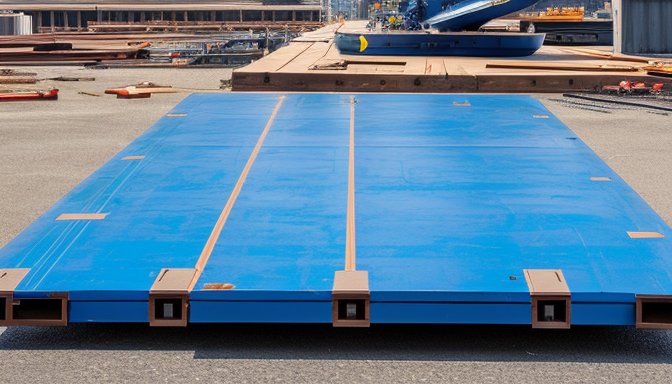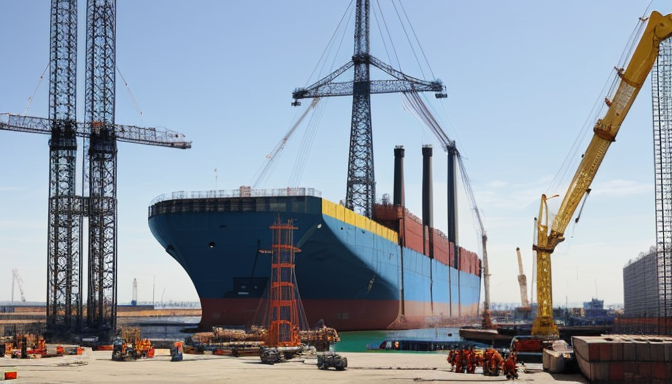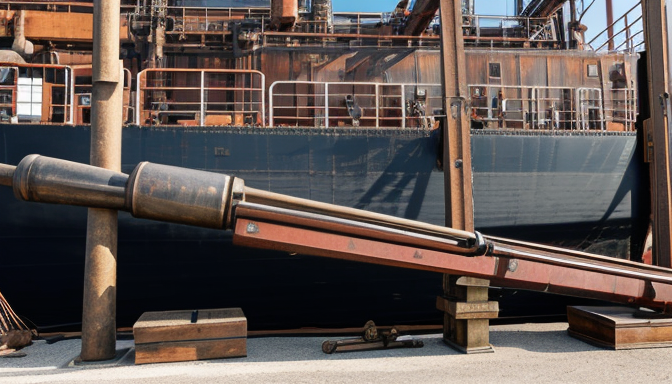When it comes to constructing vessels, the choice of materials is crucial. Among these, shipbuilding steel plates stand out as essential components. These plates are not just pieces of metal; they are the backbone of any ship. Imagine a ship as a giant puzzle. Each piece must fit perfectly, and the steel plates are among the largest and most vital pieces.
So, what exactly are shipbuilding steel plates? Well, they are thick sheets of steel specifically designed for ship construction. They provide the necessary strength and durability to withstand harsh marine environments. Think of them as the armor of a ship, protecting it from the elements while ensuring safety for everyone on board.
Now, let’s dive into why understanding these plates is important. The maritime industry faces constant challenges, from fluctuating prices to varying quality standards. Knowing about shipbuilding steel plates can help shipbuilders make informed decisions. This knowledge can save time, resources, and even lives.
In this article, we will explore various aspects of shipbuilding steel plates, including:
- Pricing: What factors influence the cost?
- Weight: How does the weight of these plates affect ship design?
- Properties: What makes a good shipbuilding steel plate?
- Sizes: What dimensions are available for different ship designs?
As we go through these topics, you’ll see how each element plays a role in the overall construction and performance of a ship. It’s like building a house; you wouldn’t use flimsy materials for the foundation, right? Similarly, ships need robust materials to ensure they remain seaworthy.
In conclusion, shipbuilding steel plates are more than just steel. They are a critical part of maritime engineering. Understanding their pricing, weight, properties, and sizes can significantly impact the success of any shipbuilding project. So, let’s embark on this journey to uncover the fascinating world of shipbuilding steel plates!
Shipbuilding Steel Plate Price
Understanding the pricing factors of shipbuilding steel plates is crucial for budgeting projects. Prices can vary widely based on several key elements. First, let’s consider the market trends. Just like the stock market, the prices of steel fluctuate. When demand is high, prices can soar. Conversely, during a downturn, costs may drop significantly. This is especially true for the maritime industry, where the need for new vessels can shift rapidly.
Next, the quality of the material plays a significant role in determining price. High-grade steel plates, which offer better strength and durability, typically come at a premium. But remember, investing in quality can save you money in the long run. You wouldn’t want to cut corners and end up with a vessel that has to be repaired frequently, right?
Another important factor is the supplier influences. Different suppliers may have varying pricing strategies based on their production capabilities, shipping costs, and even their own supply chain issues. It’s wise to shop around and compare prices from multiple sources. You might find that some suppliers offer better deals, especially if they have excess inventory.
To give you a clearer picture, here’s a simplified table showing how these factors can affect prices:
| Factor | Impact on Price |
|---|---|
| Market Demand | High demand can increase prices; low demand can decrease them. |
| Material Quality | Higher quality means higher prices, but better performance. |
| Supplier Variability | Different suppliers may offer different prices based on their own costs. |
In conclusion, when budgeting for shipbuilding steel plates, keep these factors in mind. Prices can be tricky, but with a little research, you can find the best options for your project. Always remember, a well-planned budget today can prevent headaches tomorrow.

Shipbuilding Steel Plate Weight
The weight of shipbuilding steel plates is not just a number; it’s a critical factor in the design and construction of vessels. Imagine trying to float a boat made of heavy materials. It wouldn’t work well, right? The weight influences how a ship performs in the water, its fuel efficiency, and even its stability. When selecting materials for shipbuilding, engineers must consider the balance between strength and weight.
Typically, shipbuilding steel plates are made from high-strength steel, which allows for thinner plates without sacrificing durability. This means lighter ships that can carry more cargo or travel faster. But how is the weight calculated? It’s all about the size and thickness of the plate. For instance, a standard plate might weigh anywhere from 5 to 25 tons, depending on its dimensions. To give you a clear picture, let’s look at a simple table:
| Plate Thickness (mm) | Weight per Square Meter (kg) |
|---|---|
| 6 | 47.5 |
| 10 | 79.5 |
| 12 | 95.4 |
| 20 | 158.0 |
As you can see, the thickness of the plate directly affects its weight. A thicker plate means more weight, which can impact the overall design of the ship. But why does this matter? Well, a heavier ship requires more power to move through the water. This can lead to increased fuel consumption and higher operational costs. So, finding the right balance is crucial.
Moreover, the weight of the steel plates can influence the ship’s stability. A ship that is too heavy in one area may tilt or list, which can be dangerous. Engineers use advanced calculations to ensure that the weight is distributed evenly across the vessel. This is where experience and knowledge come into play. They often rely on computer simulations and models to predict how different weights will affect the ship’s performance.
In summary, the weight of shipbuilding steel plates is a vital aspect that affects design, performance, and safety. It’s not just about using steel; it’s about using the right steel in the right way. So next time you think about ships, remember that every plate counts. The challenge is to build a strong, efficient vessel that can withstand the harsh marine environment while keeping weight in check.
Shipbuilding Steel Plate Properties
When it comes to shipbuilding, the properties of steel plates are absolutely essential. Think of it like the backbone of a ship. If the backbone is weak, the entire structure is at risk. So, what makes these steel plates special? Let’s dive into some key characteristics.
First off, we have tensile strength. This is a fancy term for how much pulling force a material can withstand before it breaks. In shipbuilding, high tensile strength is crucial. Why? Because ships face a lot of stress from waves, winds, and the weight of cargo. A plate with strong tensile properties ensures that the vessel can handle these forces without compromising safety.
Next up is corrosion resistance. Ships are constantly exposed to saltwater, which is notorious for causing rust and deterioration. Imagine leaving a metal object outside in the rain. Over time, it starts to rust, right? The same principle applies to ships. Steel plates used in shipbuilding must have excellent corrosion resistance to last longer and require less maintenance.
Another important property is impact toughness. This refers to how well a material can absorb energy when struck. Ships often encounter rough seas, and a plate that can withstand impacts without cracking or breaking is vital for the vessel’s overall integrity. Think of it as a helmet for a ship. Just like a helmet protects your head from injury, tough steel plates protect the ship from damage.
But that’s not all. The weldability of steel plates is also a significant factor. During construction, various parts of the ship need to be joined together. If the steel plates don’t weld well, it could lead to weak joints. This would be like trying to glue two pieces of paper together with a poor-quality adhesive. The bond won’t hold, and eventually, it will fall apart.
Lastly, let’s not forget about weight. While heavier materials might seem stronger, they can actually hinder a ship’s performance. A balance is essential. The right steel plates should provide strength without adding unnecessary weight. This is where material science comes into play, allowing manufacturers to create lighter yet robust options.
In summary, the properties of shipbuilding steel plates—tensile strength, corrosion resistance, impact toughness, weldability, and weight—are integral to the safety and efficiency of maritime vessels. Choosing the right materials can make all the difference between a reliable ship and one that struggles against the elements. So, next time you see a ship, remember that its strength lies in the steel plates that form its very core.

Shipbuilding Steel Plate Sizes
When it comes to shipbuilding steel plates, size matters. Imagine trying to fit a square peg in a round hole. It just doesn’t work, right? The same principle applies in shipbuilding. The right size of steel plate is essential for the structure and integrity of the vessel. But what sizes are actually available?
Generally, shipbuilding steel plates come in various thicknesses and dimensions. The most common thickness ranges from 6 mm to 100 mm. As for the width and length, they can vary significantly, often ranging from 1,500 mm to 3,000 mm in width and 6,000 mm to 12,000 mm in length. These dimensions are not just random numbers; they cater to specific needs in ship design and construction.
Different types of ships require different sizes of steel plates. For instance, a small fishing boat might need plates that are thinner and smaller, while a large cargo ship would require thicker and larger plates for strength and durability. It’s like choosing the right tool for a job. Using the wrong size can lead to structural failures, which is the last thing any shipbuilder wants.
To help visualize this, let’s look at a simple table that outlines some standard sizes:
| Plate Thickness (mm) | Width (mm) | Length (mm) | Typical Application |
|---|---|---|---|
| 6 – 10 | 1500 – 3000 | 6000 – 12000 | Small vessels, fishing boats |
| 10 – 20 | 2000 – 3000 | 6000 – 12000 | Medium-sized ships, ferries |
| 20 – 50 | 2500 – 3000 | 8000 – 12000 | Large cargo ships, tankers |
| 50 – 100 | 2500 – 3000 | 10000 – 12000 | Heavy-duty ships, offshore platforms |
As you can see, the sizes are tailored to fit various applications. This variety allows shipbuilders to select the most appropriate materials for their specific projects. But remember, it’s not just about size; it’s also about the quality of the steel. A well-sized plate made from inferior steel won’t perform well.
In conclusion, understanding is crucial for anyone involved in the maritime industry. Whether you’re a shipbuilder, designer, or even a student, knowing the dimensions and their applications can help you make informed decisions. After all, in shipbuilding, the right size can be the difference between smooth sailing and a sinking ship!
Frequently Asked Questions
- What factors influence the price of shipbuilding steel plates?
The price of shipbuilding steel plates is influenced by several factors, including market demand, the quality of materials, and supplier pricing strategies. Additionally, fluctuations in raw material costs and global economic conditions can also impact pricing.
- How does the weight of shipbuilding steel plates affect vessel performance?
The weight of shipbuilding steel plates is crucial as it directly affects the overall weight of the vessel. A heavier ship may require more fuel to operate, impacting efficiency. Conversely, using lighter materials can enhance speed and fuel efficiency, making it essential to find the right balance.
- What are the key properties of shipbuilding steel plates?
Shipbuilding steel plates are characterized by their tensile strength, corrosion resistance, and toughness. These properties ensure that the plates can withstand harsh marine environments while maintaining structural integrity. High-quality steel plates are essential for the safety and longevity of vessels.
- What sizes of shipbuilding steel plates are commonly available?
Shipbuilding steel plates come in various standard sizes to meet different construction needs. Common thicknesses range from 5mm to 100mm, and lengths can vary significantly. It’s important to choose the right size to match specific ship designs and applications.
- How do I select the right shipbuilding steel plate for my project?
Selecting the right shipbuilding steel plate involves considering the vessel’s design requirements, the environmental conditions it will face, and the specific properties needed for durability and safety. Consulting with suppliers and engineers can help ensure the right choice is made.
